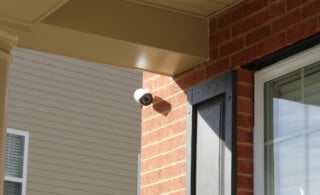
Childproofing your home is an ongoing and potentially costly process (see how much childproofing costs). This routine is made more complex for the parents of a child with a visual impairment. As your child grows and begins to explore their world, there are dozens of opportunities for accidents around the house. The average home is fraught with potential dangers for a child with low vision, partial vision or blindness. However, the home is also a place where your child will develop all the sensory skills they need to navigate the outside world. As a parent of a visually-impaired child, you will need to strike a balance between protecting your child from harm and opening their minds to the vibrancy of life. The right strategy for childproofing is crucial to success.
Even children without any disability will still stumble, trip, bump and fall. That’s why emphasizing safety during exploration is key to giving your child the opportunity to probe their environment just like any other child. This guide will give you a list of ways to balance safety with sensory exploration. In it, you’ll learn ways to:
- Adapt your home to meet your baby’s needs.
- Get your house ready to accommodate a moving toddler.
- Address general safety concerns for a child with vision impairment.
- Consider modifications you may eventually need to purchase and install.
Adapting to your baby’s special needs
Bringing home your newborn is a special and exciting time. After 40 weeks or so of waiting, your little one is finally here to be a part of your world. Focusing on making your home safe for your visually-impaired infant, before he or she begins to crawl, will help you feel less anxious and enjoy that excitement even more. Start by taking a close look at the items in your baby’s space — such as the crib, changing table and toys — and examine them and address any potential issues:
- Remove any pillows, stuffed animals, thick blankets and other objects that might cover your baby’s face and prevent them from breathing.
- Little ones are notorious for putting just about anything they can get their hands on into their mouths, so be sure baby can only reach toys and objects too big to be swallowed. Check everything for small, detachable parts that could be pulled off and ingested.
- Keep cords from window shades put up and out of reach. Babies and toddlers often try to play with them and risk getting tangled.
- Keep your baby near you while you go through your daily routine. Remember that since they may not be able to watch you, your baby will have to learn about these activities through sound. Put your baby nearby while you do dishes or laundry so that they can become familiar with those sounds and know what those activities mean. Not only will it help your baby learn, but it will also reassure them about their safety.
Accommodating a moving toddler
All parents worry about their children’s safety, but as the parent of a child with a visual impairment, you know that there are additional safety concerns you must tackle. A child that can’t see throughout the house very clearly, or possibly at all, needs special accommodations in order to safely and comfortably explore their environment. Crawling and walking bring on a new era in your child’s life, and by putting safety first, you can ensure the vision impairment doesn’t limit their ability to grow, play and develop. These tips can assist you in helping your child learn about the world, but in a safe, creative way that keeps them protected from harm in the home.
- Start by viewing the world from your child’s perspective by exploring each room as your child would — on your hands and knees. It’s a clever way to examine their paths and eliminate possible dangers that you may overlook.
- Put fragile items in a protected place, like on high shelves, blocked by furniture or in rooms closed off by baby gates and locked doors.
- Secure cleaning products and medications in elevated cabinets protected by safety locks that are simple for adults to open but challenging for children.
- Set up baby gates at the top and bottom of steps and stairs, no matter how short or long they are.
- Cover your electrical outlets and use electric cord shorteners.
- Install corner protectors or wrap the bottom portion of hard furniture in foam or another kind of soft padding. Also, avoid tablecloths or decor that hangs over the edges of tables so that your child won’t try to use these unstable items to pull themselves up.
- Secure the edges of small rugs with tape, or remove rugs altogether.
- Close closet and cabinet doors to keep your child from bumping into them.
- Everyone in the household needs to take an active — and even proactive — role in keeping the house clear of clutter, like making sure toys, clothes and other belongings are not left on the floor where they could be tripped over.
- Never leave your child alone in an area with a potential hazard, like a tub filled with water, a kitchen with a boiling pot, or a bedroom with articles of clothing on the floor.
General safety concerns for a child with vision impairment
There are safety issues you should be on top of for a child of any age with low or partial vision or blindness. Get into these habits even before your baby arrives so that the adjustment is something ingrained in your whole family when the time comes. Try to:
- Keep pet food and water bowls off the floor. Place your cat’s litter box in a room or area that your child doesn’t have access to.
- Children with low vision can see important details with contrasting colors. Consider changing the color of your flooring between rooms to let your child know which rooms they have entered.
- Children without vision can learn to navigate rooms using tactile cues. Change the flooring material from room to room to help your child know where he or she is. As they grow and start to walk, consider using textured paint or motion sensors with specific chimes to alert your child to the area in the home they are about to enter.
- Avoid moving or bringing in new furniture to keep changes to the environment minimal. You may even want to forego holiday decorations at first. Wait until your child is old enough to have changes explained to them and ample opportunity to explore them.
Modifications you may need to purchase and install
Over the years, as your child grows and develops, you may need to purchase special equipment and hire a remodeling contractor to install modifications for better accessibility and to help make your home simpler to navigate. Some of these modifications include:
- Installing handrails in areas where your child may risk a slip or fall, like next to the bathtub or toilet, down the stairs and in the laundry room.
- Keeping up on home repairs, like carpet peeling or broken furniture.
- Using textured markings on appliance buttons and switches.
- Installing non-slip flooring.
- Using textured hangers in the closet to categorize clothes by type, style or color.
- Hiring lawn care services, or cutting the grass and hedges regularly and making sure tree branches are trimmed back.
Childproofing your home is a lifelong process, especially for the parents of children with vision impairment. The earlier you implement these modifications, the more quickly and confidently your child will come to understand them. Making the home safe for a growing child is every parent’s priority, and taking these extra steps to accommodate vision impairment will help make your home a happy, healthy place for your little one.
 Chimney Bombs
Chimney Bombs  Electrical Hazards
Electrical Hazards  Gas Detectors
Gas Detectors  Child Safety Guide: How to Keep Kids Safe When They’re Home Alone
Child Safety Guide: How to Keep Kids Safe When They’re Home Alone  Home Motion Detectors Secure Your Safety
Home Motion Detectors Secure Your Safety 

Are You Familiar With This Topic? Share Your Experience.